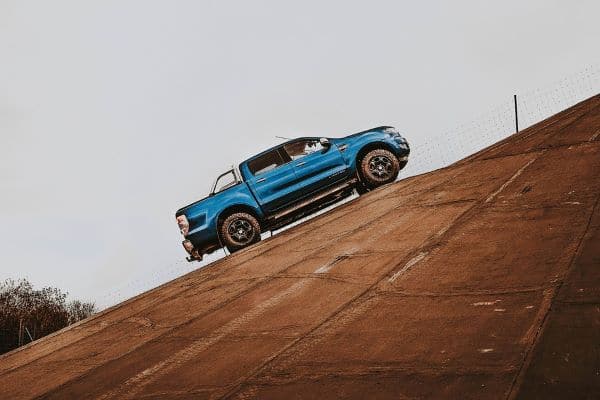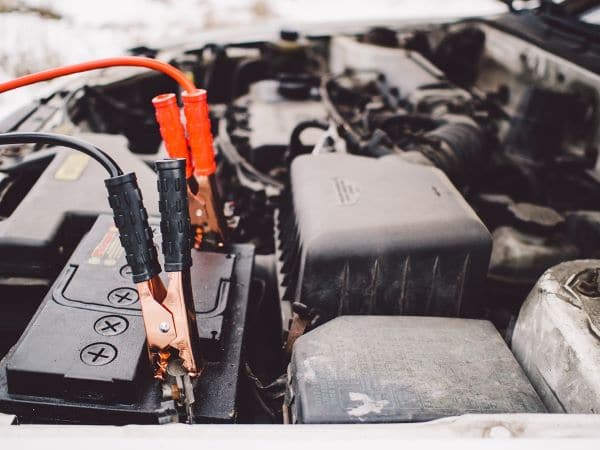Your Ford Ranger won’t start one click. We’ve all been there. You get out to your truck in the morning to head for work and you can’t start the engine. What do you do when the Ford Ranger won’t start one click? Ford Ranger starter problems aren’t unheard of, so that might be the issue. However, there are plenty of other explanations, so you don’t want to jump the gun. In some cases, you might just need to charge the automotive battery to get running again.

We explore the reasons why your Ford Ranger won’t start one click sometimes and look for ways to fix it. Our guide should help you get back on the road, hopefully before you are late for work.
Table of Contents
5 Reasons Ford Ranger Won’t Start One Click
The clicking alone can tell you a lot about why your truck won’t start. For example, when the Ford Ranger won’t start and no click occurs, the issues are going to be different than if there is continuous clicking or only one click. Oftentimes, the clicking points to a battery or electrical problem. However, the one click can be traced to the starter itself.
We will look at all of the possible reasons your Ford Ranger won’t start one click to see if you can pinpoint the problem. While this isn’t an exhaustive list of causes, these are the most common.

1. Drained Battery
The most obvious reason that the Ford Ranger won’t start one click is due to the battery. If you left the headlights on overnight, then you probably already know this is the cause.
However, the battery can drain even if you’ve done nothing wrong. It could simply be old or there could be a parasitic drain that needs to be worked out. If this is the problem, a jump start should resolve the situation and get you back on the road. However, if the battery continues to die, you may be facing something larger, such as a defective alternator.
Here are a couple of reasons that the battery might also be drained.
Battery Corrosion
It’s possible that the battery can’t charge because of corrosion. Battery corrosion is caused by the hydrogen gas that is released from the sulfuric acid found in the battery. When the gases hit the atmosphere, it starts to corrode on the terminals.
In many cases, the corrosion is the result of overcharging the battery. Thankfully, cleaning the corrosion requires a simple solution of baking soda and water. Just remember to wear gloves while working with the battery.
Loose Cables or Connections
The battery isn’t able to charge if there are loose connections. Over time, road vibration can take a toll on these connections, which is why they should be checked regularly. If the Ford Ranger starting problems are electrical, you can easily fix them.
When the cables aren’t making good electrical contact, you can tighten them. While you have them off, it’s also a good time to clean any corrosion you see.
Failed Alternator
The other possible reason the battery is drained is because the alternator died. If you charge the battery, but it fails again, this could be the reason.
The alternator is responsible for charging the battery while the engine is running. It takes a lot of juice to start the vehicle, so if that charge isn’t replaced, you end up with a dead battery.
However, most people don’t know that the alternator is the culprit until the battery has been replaced first. You can test the alternator if you suspect it is to blame.
2. Dead Battery
This might sound like the same problem as the last, but it’s actually completely different. When the battery gets old or worn out, it will no longer hold a charge. Jumpstarting it isn’t going to change anything.
In general, a car battery is going to last three to five years, depending on how you drive and the conditions it is used in. If you spend a lot of time driving, you are keeping the battery in good health. However, if you only take short drives, you will want to use a battery charger to ensure it remains in optimal condition.
The only solution to a dead car battery is to replace it.

3. Starter Motor
On the other hand, you might be looking at trouble with the starter motor, especially if the solenoid clicks but the starter won’t turn. If the battery is charged and you hear one click, you are likely facing trouble with the Ford Ranger starter relay.
You can tell the battery is charged because the headlights, radio and other electrical accessories are going to work normally.
The starter solenoid could also be to blame because it is responsible for engaging the starter motor to turn the flywheel and crank the engine. Unless you understand Ford Ranger starter solenoid wiring, it’s best to leave this problem to the professionals.
4. Failed Ignition Switch
The ignition switch is located behind the lock cylinder. These two parts work together to start your Ford Ranger. In most cases, the switch turns on the accessories with the first position, ignition and fuel systems with the second position and cranks the engine with the third.
If you have Ford Ranger ignition switch problems, you might be facing a bunch of other symptoms along with having an engine that won’t crank. For starters, the truck might start and die. It could also fail to start but won’t make any clicking sound.
5. Malfunctioning ECM
The Engine Control Module (ECM) manages all of the engine timing, fuel-to-air rations and on-the-go adjustments that keep your Ranger moving. It also communicates with the TCM and PCM for a smooth journey.
If you are facing Ford Ranger ECM problems, you might first see the Check Engine Light or notice a decrease in performance. However, over time, the problem could get bad enough that the engine won’t start. In some cases, it might crank but not start at first, yet work on a second or third try. This is a sign that you need to replace the ECM immediately before you are stranded.
What to Do When Your Ford Ranger Won’t Start One Click
When your Ford Ranger won’t start one click, you need to determine what is causing the problem. We will outline some troubleshooting steps that should narrow down the fault.

Ford Ranger Doesn’t Start With a Repeated Click
If you hear a rapid clicking or chattering sound, the issue is probably related to the battery, electrical connections or alternator. When the starter can’t get enough power to crank the engine, the attempts result in a clicking sound.
You can follow these troubleshooting steps.
- Jump-start the truck. If it starts up and dies again, the problem might be the alternator. However, if it starts and continues running as expected, the battery charge might just have been low. You will either want to drive for thirty minutes or use an external charger to bring the battery back to life.
- Inspect the battery cables for corrosion. Clean off any corrosion you see and check the connection of all the cables.
- If you continue to get a clicking response, you want to test the battery. With a multimeter, you can examine the voltage of the battery. A good automotive battery with a full charge will read 12.6 volts without the engine running. If the vehicle were running, the battery would register 13.7 to 14.7 volts instead. Any battery that features low voltage should be replaced.
- After recharging or replacing the battery, everything should operate as normal. If it doesn’t, you might have a failed alternator that can’t charge the battery. In some cases, your local auto parts store will test the alternator for you, just like they will with the battery.
Ford Ranger Wont Start One Click
In most cases, the Ford truck that only offers a single click with a no-start situation is struggling with a failed starter or bad starter relay. Along with this problem, you might hear a rumbling or grinding sound.
Here are the ways to troubleshoot the starter.
- Locate both the starter and starter solenoid. The solenoid is on the bell housing or transmission housing, found on the driver’s side. The starter will be cylindrical and about eight inches long. The solenoid is bolted to it with two wires attached to the back.
- Find the metal contacts that attach the solenoid with the ignition and the solenoid with the starter motor. The wires found on the back are connected to these metal contacts.
- You need to construct a bridge across the metal contacts. You can do this by using an insulated screwdriver’s shaft. This bridge acts as a connection between the starter motor and ignition.
- Have a friend turn the ignition on. If the starter motor lets out a consistent hum and works, the starter is working as it should. In this case, you would need to replace the solenoid.
- If the starter motor doesn’t run, the brushes inside are probably worn out. In this case, you will need to replace the starter motor.
How to Replace a Ford Ranger Starter
With some mechanical knowledge and the right tools, you can replace your Ford Ranger starter. Give yourself a couple of hours to get the job done.
Tools Needed
- Screwdriver set
- Socket set
- Floor jack and jack stands
- Pliers
- Wheel chocks
- New starter
Safety Considerations
Whenever you work on your vehicle, you want to take a few steps to remain safe. In addition to the supplies listed above, you might also consider wearing non-conductive mechanic gloves, close-toed shoes, slim-fitting clothing and safety glasses.
Organize your work area and tools ahead of time, so you aren’t searching for things during the repair. Park your vehicle on a flat surface and always ask a professional if the job seems too complicated for your skill level.
Instructions
With all of that out of the way, you are ready to replace your Ford Ranger starter. The job isn’t actually that complicated if you have some mechanical knowledge. Here are the basic steps to follow, although some models could be slightly different. Consult your Ford Ranger service manual for more guidance.
- Disconnect the battery terminals.
- Lift the truck and secure it on jack stands.
- Find the starter motor. The Ford Ranger starter motor is at the base of the engine, located on the driver’s side. You will spot it next to the transmission’s bell housing, where it meets the motor.
- Remove any components that get in the way of accessing the starter motor.
- Disconnect the connections to the starter motor.
- Take off the Ranger starter motor.
- Replace it with a new model.
- Put all of the connections back in place.
- Replace the parts you had to remove to get to the starter, if necessary.
- Lower your truck back to the ground.
- Connect the battery terminals.
- Try starting the engine again. It should work this time.
- Enjoy the open road and be grateful you aren’t without transportation any longer.
If you learn better from a visual explanation, check out this helpful Ford Ranger starter motor replacement video that shows you what to do.
Final Thoughts
Your heart might sink when the Ford Ranger won’t start one click. We understand the feeling completely. However, our comprehensive guide should have helped you pinpoint the problem. You now know what to do if the battery is dead, the alternator has failed or you need to replace the starter. With a little work, you will be back on the road enjoying your Ford truck once again.
